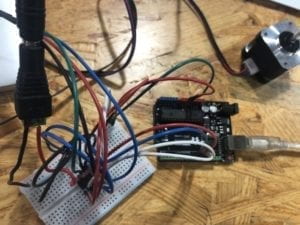Introduction
In the 4th recitation we were asked to make a drawing machine using a stepper. First I built a very complex circuit to include the stepper, then I added a potentiometer to the circuit to control the rotation of the stepper, and finally I paired with a classmate to make a real drawing machine. My partner Yiwen Hu and I successfully built a drawing machine and drew a “beautifully messy” picture.
Step 1: Building the Circuit
Materials:
1 * 42STH33-0404AC stepper motor
1 * L293D ic chip
1 * power jack
1 * 12 VDC power supply
1 * Arduino kit and its contents
In the first step, the very first thing to pay attention to is the position of the IC (Integrated Circuit, or H-Bridge). To identify the pin number, we need to look for the semicircle at its end. And Pin 1 is to its left, as indicated below. I almost got it wrong in the beginning.

After making sure I did orient the IC correctly, I slowly built a very complex circuit. The schematic is pasted below. It is worth noting that the wires of 5V and 12V cannot be connected together, but the wires go to the same ground. I tested my circuit first to see if the stepper motor could rotate once successfully, and luckily it did. But I think this circuit is really complicated and it took me a long time to finish building it.


Following the schematic I built the circuit above. And it works well.
Step 2: Control rotation with a potentiometer
To control the rotation of the stepper motor, we need a potentiometer. After connecting a potentiometer almost every class, I finally remember where the wires should go from the 3 different ports. Also, we need to modify the code and make sure the number of steps within the code is in line with that of the motor (in this case, a 200-step motor). And we need to use “map()” to make the motor rotate in the same direction as we rotate the knob.
part of the code:
int val = analogRead(0);
map(val, 0, 1023, 0, 200);
The motor rotates in the same direction as the knob:
Step 3: Build a Drawing Machine!
Then I paired with Yiwen Hu to combine our motors and make a drawing machine. My motor is on the right and Yiwen’s is on the left. Mine seemed to work fine, but Yiwen’s motor was not rotating much, it kind of just vibrated. We did not know exactly the cause of the issue, but I guess there might be something wrong in step 2 with Yiwen’s motor. But anyway the drawing machine seemed to work fine.
Question 1: What kind of machines would you be interested in building?Add a reflection about the use of actuators, the digital manipulation of art, and the creative process to your blog post.
I am interested in building a lucky cat. It can work with a similar actuator we used in this recitation. It would also need a distance sensor, so that it can detect people when they go near and start waving its hand as a welcome, which means soliciting customers and fortune. I think the basic principle behind lucky cats sold in shops is pretty simple and achievable with our experience with sensors and motors.
Question 2: Choose an art installation mentioned in the reading ART + Science NOW, Stephen Wilson (Kinetics chapter). Post your thoughts about it and make a comparison with the work you did during this recitation. How do you think that the artist selected those specific actuators for his project?
One installation that caught my attention in the reading is Gastarbyter by London Fieldworks. I think the installation appears very unique – a human is trapped in an enveloping chair with strange noise and light going on around him. The artists’ purpose behind the design is to create “an intense multi-sensual experience.” I think it is about infiltration and differentiation of different human senses like sound, sight and touch. We are often overwhelmed by our sight and pay little attention to listen or feel the world around us. I think this installation is a metaphor that encourages people to listen and feel more in daily life.
Compared to what I did in the recitation, this installation involves more aspects and offers multi-sensual experience, while my drawing machine is primarily for sight only.